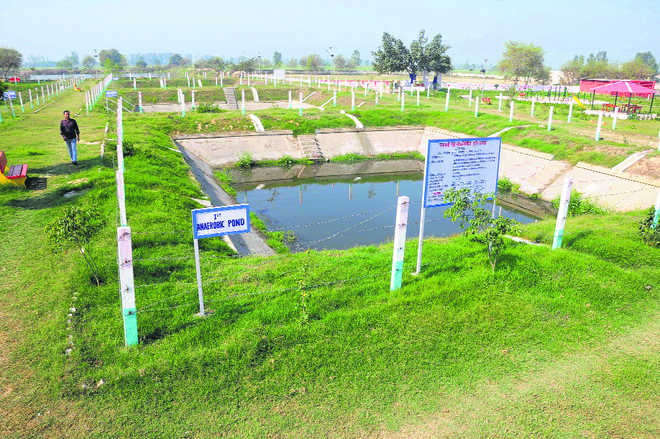
Facelift: The area around a pond of untreated and accumulated water now has a park, open gym and other recreational facilities at Kurak Jagir Village in Karnal. Tribune photos: Sayeed Ahmed
Parveen Arora in Karnal
The rural Swachh Bharat Mission, after all, can work if there’s willingness. Here is how Kurak Jagir village and 14 others in Karnal are changing their landscape. Not long ago these villages overflowed with filthy, stinking water; and waterborne diseases were common. Today, the village johad (ponds of untreated, accumulated water) have given way to parks, open gyms and other recreational facilities. “Our village (Kurak Jagir) has become a picnic spot,” exclaims Sudesh Kumar, sarpanch.
All this is thanks to a five-pond system: the ‘johad’ water has now become a source of recharging groundwater, being used in agriculture and fisheries. The system is part of the Swachh Bharat Mission (Gramin) launched by Prime Minister Narendra Modi in October 2014.
And this is how the five-pond system works: There are two colours of dirty water, grey and black. Grey water is wastage from bathroom, washing clothes and kitchen. The black water is toilet waste and requires biological or chemical treatment and disinfectants before reuse.
- First, the filthy water of a village is collected through drains at a common point. It is then passed through the iron mesh of various shapes to separate heavy sediments.
- Second, the water is allowed to pass through two large shallow basins where heavy silt settles down and the pathogenic content is reduced. The stabilized water is sent to a pond known as anaerobic (impervious to oxygen) pond (10-ft deep) and later in a second pond named as alternative anaerobic pond, where water is retained for two-three days. This way, solids present in the water settle down and are absorbed in anaerobic way.
- Third, this water is allowed to enter the third and fourth ponds five feet deep. The water is retained for at least four days in these ‘facultative ponds’ (where, for instance, a plant has the capacity to live under more than one specific set of environmental conditions or a bacterium that can live with or without air).
- Fourth, the oxidation of this water takes place. Solids are generally taken care of by three mechanisms: aeration through the surface, oxidation through photosynthetic activity of algae growing in the pond because of the availability of plant nutrients and the light energy from the sun. The pond bacteria utilize the algae oxygen to metabolize the organic solid contents of the grey water.
- Fifth and final, the water is released in the last and final pond known as the maturation pond (5-foot-deep). The water is retained for another five days to destroy the pathogens.
The water thus treated can be used for irrigation and fish farming.
The system was initially taken up in Sirsi and Shahpur villages. After its implementation, it earned appreciation from the villagers. The district administration has now 71 villages earmarked under the Swachh Bharat Mission, says Ramphal Singh, executive engineer, panchyati raj.
On the demand of Nilokheri and Indri MLAs, the government on Feb 26 decided to form a pond authority in Haryana. The authority’s job is to protect, conserve, develop and rejuvenate the village ponds. In the first phase, all ponds in the Indri block of the district will be taken up.
Encroachments, destruction, growing urbanization and industrial activities have led to disappearance of many village ponds in the state. The traditional source of surface water storage has all but vanished. The authority will help in developing the five-pond system, said an official.
“Our attempt is to find an end-to-end solution through the five-pond system, where waste water from households is collected through an effective drainage system. This water is treated for reuse. Keeping in mind the population, topography and the number of ponds, a complete solution for agricultural purpose and for providing drinking water for animals has been initiated,” says Aditya Dahiya, deputy commissioner.



























